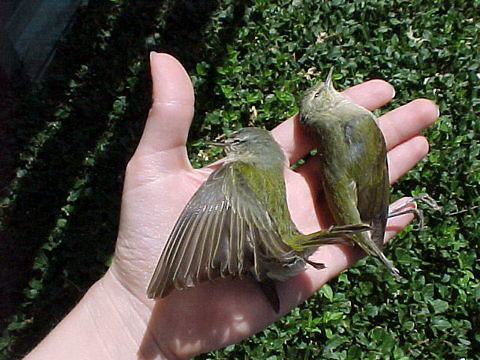The previous post showed a mere outline of the awesome-yet-to-come:
The actual screening on the shirt, of course, is by Louise Zemaitis - now autographed, initialed and accompanied by fangirl antics. Who knew birders had such rabid fans? Oh, wait.
Sleeve art by Michael O'Brien... how awesome is that? Clearly another perched Black-and-white Warbler would have been too boring, but way to one-up the original art!
26 November 2011
17 November 2011
RGV Birding Festival
We may or may not have seriously nerded it up over the weekend:
Louise Zemaitis autographed her Black-and-white Warbler shirt
Michael O'Brien drew another Black-and-white Warbler on the sleeve of the shirt
Jon Dunn autographed the newest Nat. Geo. on our honeymoon spindalis page
...and we wrangled a booth all weekend, too!
Louise Zemaitis autographed her Black-and-white Warbler shirt
Michael O'Brien drew another Black-and-white Warbler on the sleeve of the shirt
Jon Dunn autographed the newest Nat. Geo. on our honeymoon spindalis page
...and we wrangled a booth all weekend, too!
05 November 2011
The "why" of window monitoring
Birds hit windows. It's pretty much impossible to overstate the extent of the issue. Pretty much everyone knows that it happens but very few people look beyond face value of the smudge on glass.
This is more eloquent than anything I've seen yet, so please take a look at
Tim O'Connell's piece: A window into the perils of migration. He beautifully outlines the "how" and "why" of dead birds as educational tools, as well as one example of the mind boggling architecture that causes such high mortality rates. Flat-sided buildings are bad enough, but a horseshoe with a 'corridor effect' cluster at one end? Yikes!
On a coincidental note, I'm about half way into a paper on the complexities of North American window collisions - they've been my constant companion since 2003 and I need to get my thoughts out of my head and into writing. Unfortunately it's a rather dry, sciency sort of writing, but I think the discussion will be helpful. It's just terribly difficult to keep citations sorted out since there are about 20 papers that cite each other ad infinitum and the resulting citation loop is frustrating. One paper that I criticize lists my paper in its citations, too, for that matter!
Anyway, here are some lovelies - Tennessee Warblers - from Principia, circa 2004-2005 (a tiny fraction of the actual species diversity and even fewer of the overall body count.)

External link: dead bird album
This is also cross-posted over at Big Bend Birds & Nature.
This is more eloquent than anything I've seen yet, so please take a look at
Tim O'Connell's piece: A window into the perils of migration. He beautifully outlines the "how" and "why" of dead birds as educational tools, as well as one example of the mind boggling architecture that causes such high mortality rates. Flat-sided buildings are bad enough, but a horseshoe with a 'corridor effect' cluster at one end? Yikes!
On a coincidental note, I'm about half way into a paper on the complexities of North American window collisions - they've been my constant companion since 2003 and I need to get my thoughts out of my head and into writing. Unfortunately it's a rather dry, sciency sort of writing, but I think the discussion will be helpful. It's just terribly difficult to keep citations sorted out since there are about 20 papers that cite each other ad infinitum and the resulting citation loop is frustrating. One paper that I criticize lists my paper in its citations, too, for that matter!
Anyway, here are some lovelies - Tennessee Warblers - from Principia, circa 2004-2005 (a tiny fraction of the actual species diversity and even fewer of the overall body count.)

External link: dead bird album
This is also cross-posted over at Big Bend Birds & Nature.
Labels:
birds,
dead birds,
introduction,
research,
tree hugging,
windows
04 November 2011
Subscribe to:
Comments (Atom)























